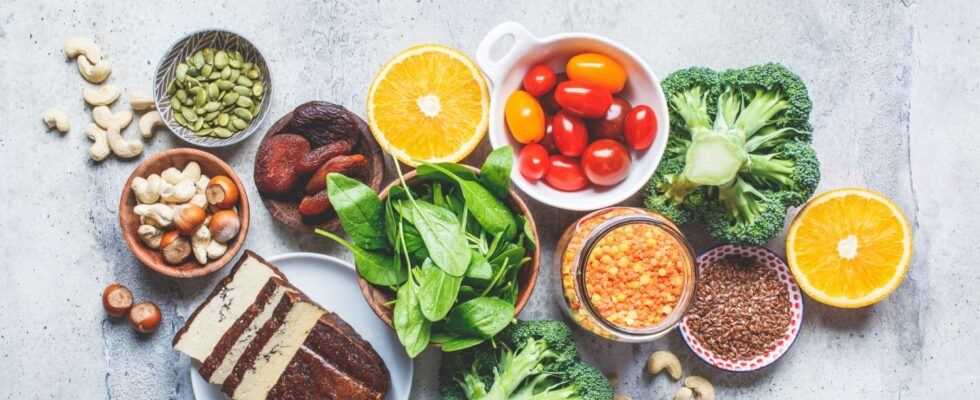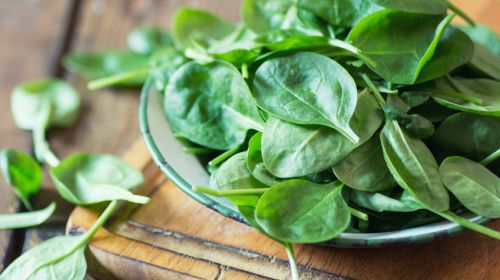Iron is involved in many vital reactions in the human body, for example blood formation or oxygen transport. The trace element must be supplied through food – if the body does not get enough, there is a risk of iron deficiency.
- Ferrous foods prevent iron deficiency.
- © iStock.com/vaaseenaa
Iron is an essential trace element. The human body contains around two to four grams of iron. Over two thirds of this is in hemoglobin, the oxygen carrier of red blood cells. Iron is mainly needed for blood formation and oxygen transport. The mineral also serves as an oxygen store in the muscle cells and is involved in the generation of energy in the cells.
Most men hardly have to fear an iron deficiency. Women, on the other hand, have a much higher need for the vital trace element. When it comes to nutrition, foods containing iron should therefore be at the top of their menu. Iron is mainly found in meat, but also in many plant-based foods.
Article content at a glance:
Iron deficiency: symptoms are paleness, tiredness or susceptibility to infections
Iron deficiency is one of the most common deficiencies in developed industrial countries. In most people, iron deficiency manifests itself with characteristic symptoms. If you notice this over a longer period of time, you should consult your family doctor in good time. He can use a blood count to find out whether there is actually an iron deficiency or whether another disease is responsible for the symptoms. The doctor can also diagnose the cause of the iron deficiency and initiate appropriate treatment.
Symptoms of iron deficiency:
However, iron deficiency should not be combated on suspicion or on your own. If the doctor has determined the iron deficiency, he can prescribe appropriately dosed iron supplements. These are either taken as tablets or infused into the bloodstream.
Causes of Iron Deficiency
Maintaining the balance of iron in the body is a finely tuned balance in which iron intake must be adapted to the body's iron needs. For this reason, malfunctions such as iron deficiency or iron overload can occur relatively quickly.
Iron is absorbed through foods containing iron, and the trace element is absorbed in the stomach and duodenum. Iron that is not required is stored as ferritin in the liver and spleen, in the intestinal mucosa and in the bone marrow, from where it can be activated to form blood if necessary.
The body excretes very little iron in sweat, urine and stool – the loss is around one milligram per day. In women, however, larger amounts of iron are lost during each menstruation, namely up to 35 milligrams per cycle.
Other causes of iron deficiency:
- Bleeding in the gastrointestinal tract
- Chronic blood loss, for example due to heavy menstrual bleeding
- Chronic illnesses such as celiac disease, chronic diarrhea, chronic inflammatory bowel disease
- One-sided diet, vegetarian or vegan diet
- Gastric ulcer
- Medicines (some active ingredients inhibit the absorption of iron, for example acetylsalicylic acid (ASA) or antacids
- Operations on the stomach and intestines
- Decreased intake with food
Increased need: women are often iron deficient
The loss of iron through body excretions must be compensated for through food, because the body cannot produce iron itself. However, because only about ten to 15 percent of the iron contained in food can be absorbed and used by the body (bioavailability), the recommended daily amount is much higher. The German Nutrition Society (DGE) recommends that men consume ten milligrams of iron per day.
Women have an increased need for iron. At childbearing age, this is around 50 percent higher than that of men. During pregnancy, the female body needs more iron (30 milligrams) for the increased blood volume, the development of the placenta and the supply of the growing baby with oxygen. In the postpartum period, more iron should also be consumed to make up for the losses. The DGE recommends a daily amount of iron of 30 milligrams for pregnant women, 20 milligrams after the birth.
More of the vital element is also needed in growth phases such as teenagers, because various metabolic processes take place with the help of iron: In boys, muscle mass and blood volume increase sharply within a short time. In girls, iron is also lost through menstrual bleeding.
Table: Daily iron requirement according to DGE recommendations
| Age | Iron per day | |
| male | Female | |
| 1 to 7 years | 8 mg | 8 mg |
| 7 to 10 years | 10 mg | 10 mg |
| 10 to 19 years | 12 mg | 15 mg |
| 19 to 25 years | 10 mg | 15 mg |
| 25 to 51 years | 10 mg | 15 mg |
| 51 to 65 years | 10 mg | 10 mg |
| over 65 years | 10 mg | 10 mg |
Even competitive athletes, people who regularly donate blood and people with diseases of the kidneys, the intestines (Crohn's disease, ulcerative colitis), the heart and with tumors have an increased iron requirement.
Iron deficiency can lead to anemia
If the iron requirement is not regularly balanced through food, the body's own stores can quickly empty. If there is an iron deficiency, blood formation no longer takes place smoothly – anemia can result. This manifests itself among other things by loss of appetite, gastrointestinal complaints, paleness, dull hair, cracked corners of the mouth (fissures), burning tongue, palpitations, heart problems, tendency to collapse and shortness of breath during exercise.
Cover requirements with foods containing iron
In order not to have an iron deficiency in the first place, enough iron-containing food should always be on the table. The best sources of iron are meat, liver and sausage products because the iron from them is best available to the body. Legumes, nuts and products made from whole grains such as oat flakes, grain germs or whole grain bread as well as vegetables such as spinach, salsify or Jerusalem artichoke are very iron-rich. Soybeans can also show a lot of the trace element. At the same time, they contain many phosphate compounds, which in turn inhibit the absorption of iron.
Bioavailability of iron from plant and animal sources varies
Iron is found in almost all foods, both vegetable and animal. A balanced, wholesome diet would in principle give the body enough iron. However, the body uses the trace element supplied with food differently: iron from fish and meat is very soluble in fat and is used with almost no restrictions. Iron from plant-based foods, on the other hand, is more difficult to absorb.
Certain substances in food can also promote or inhibit the absorption of iron. Vitamin C increases the absorption of iron, especially from plant foods. Fiber, calcium from milk and milk products, oxalates in rhubarb and spinach and tannins in tea and coffee inhibit or make it more difficult for iron to be absorbed in the intestine. Therefore, it is best to leave about two hours after a meal before drinking a coffee or tea.
Table: Foods that contain at least 15 percent of the recommended daily requirement of iron in one serving
| Food | Serving size | Iron content per serving |
| Meat and poultry | ||
| Veal: schnitzel | 100 g | 3.0 mg |
| Veal knuckle | 100 g | 3.0 mg |
| Beef: fillet | 150 g | 3.5 mg |
| Beef: loin | 150 g | 3.8 mg |
| Pork: fillet | 100 g | 3.0 mg |
| Pork: chop | 150 g | 2.7 mg |
| Pig: Schnitzel | 150 g | 3.5 mg |
| Saddle of venison | 100 g | 3.0 mg |
| Rabbits | 100 g | 3.5 mg |
| Hare | 150 g | 3.6 mg |
| goose | 150 g | 2.9 mg |
| Turkey, leg | 150 g | 3.0 mg |
| duck | 150 g | 3.2 mg |
| vegetables | ||
| Swiss chard, raw | 100 g | 2.7 mg |
| Black salsify, raw | 100 g | 3.3 mg |
| Spinach, raw | 100 g | 4.1 mg |
| Broccoli, raw | 200 g | 1.6 mg |
| Cauliflower, raw | 200 g | 3.2 mg |
| Peas, green, raw | 200 g | 3.8 mg |
| Carrots, raw | 200 g | 4.2 mg |
| Cereals and bread | ||
| rye | 60 g | 1.7 mg |
| Whole grain oatmeal | 60 g | 3.1 mg |
| oats | 60 g | 3.5 mg |
| millet | 60 g | 5.4 mg |
| Wheat toast | 175 g | 1.8 mg |
| Wholemeal and whole wheat bread | 175 g | 1.8 mg |
| Mixed rye bread | 175 g | 4.0 mg |
| pumpernickel | 175 g | 4.2 mg |
| Rye meal and wholemeal bread | 175 g | 5.3 mg |
| fruit | ||
| Mirabelle plums | 200 g | 2.2 mg |
| Currants, black | 200 g | 2.6 mg |
| Elderberries, black | 200 g | 3.2 mg |
| Strawberries | 200 g | 3.8 mg |
Prevent iron deficiency in a vegetarian and vegan diet
Vegetarians and vegans today usually have no lower iron levels than people who eat meat. Anyone who refrains from meat or all animal products should therefore pay attention to their iron intake. Oats, millet and other grains, for example, provide a lot of iron. Iron from plant-based foods is more poorly absorbed by the body than animal foods and is also available in smaller quantities. It is therefore important to choose vegetables with a high iron content such as spinach or parsley and combine them with foods rich in vitamin C. This could be currants, oranges, acerola cherries and lemons or a glass of orange juice with your meal. For vegetarian Egg yolk is also a good source of iron.

